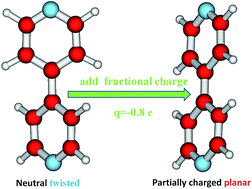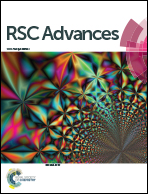Tuning the conformation of floppy molecules by charge transfer
Abstract
Recent advances in electrochemistry and nano- and molecular electronics made it possible to prepare and study molecular species having fractional charges (q ≠ 0, ±1, …) that can be continuously tuned by biases. The main focus of this communication is on the impact of continuously tuning the fractional molecular charge on the molecular conformation, an effect expected to be pronounced especially in molecules possessing floppy degrees of freedom. The (4,4′)-bipyridine molecule is considered here as a benchmark case, since the torsional angle between the two pyridyl rings is known to be related to a floppy degree of freedom. Among the specific findings of this investigation one can mention the fact that, to achieve planar conformation (hence maximum electron transmittance), complete reduction (q = −1) is not necessary; the molecular conformation becomes planar already at q ⋍ −0.8. Implications of the specific results reported here for molecular electronics (e.g., molecular switches) are briefly discussed.


 Please wait while we load your content...
Please wait while we load your content...